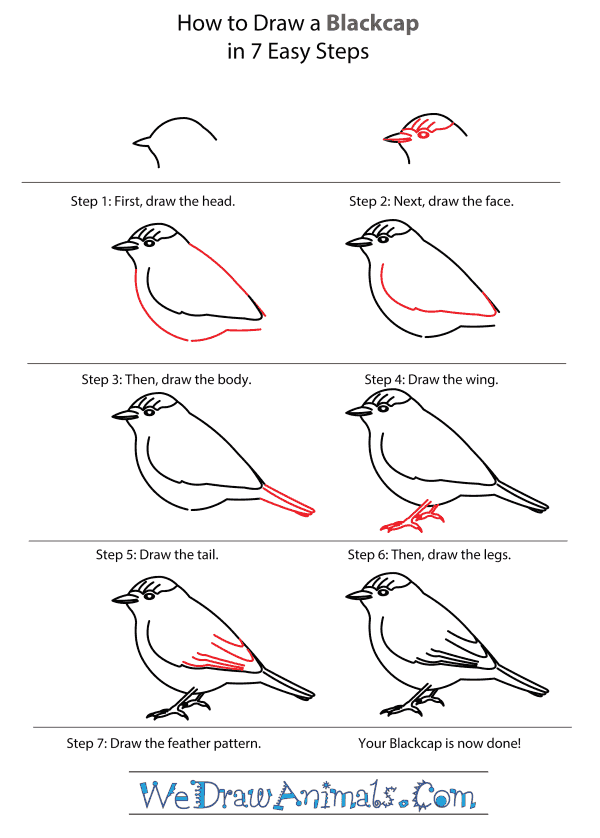In this quick tutorial you'll learn how to draw a Blackcap in 7 easy steps - great for kids and novice artists.
The images above represent how your finished drawing is going to look and the steps involved.
Below are the individual steps - you can click on each one for a High Resolution printable PDF version.
At the bottom you can read some interesting facts about the Blackcap.
Make sure you also check out any of the hundreds of drawing tutorials grouped by category.
How to Draw a Blackcap - Step-by-Step Tutorial
Step 1: First, draw the head with a short, thin beak in the middle.
Step 2: Draw the face by adding lines to the beak and from the top of the head to create feathers. The eye should be a circle behind the back of the beak
Step 3: Next, draw the plump body of the Blackcap by using one deeply curving line for the belly and one nearly straight line for the back.
Step 4: Let your Blackcap fly by adding a curved line that begins at the chest and connects to the back line.
Step 5: Now, draw the short tail by drawing a rectangle that connects to the back of your bird. Draw a line in the center of the tail to show off your bird's feathers.
Step 6: Lastly, draw the legs and feet by connecting two thin lines to three points which are the feet of your bird. Draw the leg furthest from you much shorter than the first leg and attach it slightly closer to the back of the bird than the first.
Interesting Facts about the Blackcap
The blackcap (Sylvia atricapilla), or Eurasian blackcap, is a common warbler. It is usually olive grey on top and light grey on its belly. Males have a black looking cap on their head, while females have a reddish one.
Did you know?
- There are five subspecies of the blackcap, though they are all similar looking.
- They are found in most of Europe, western Asia and northwestern Africa, and they prefer to live in wooded areas.
- Blackcaps have a very distinct and beautiful song that is widely referenced in music and literature, and earned it the nickname “the mock nightingale.”
- Fossils found in France indicate that the blackcap’s genus dates back 20 million years.
- Males who have bred before return to their same territory every year, usually in wooded areas with high perches and plenty of overgrowth.
- Males attract females with song, movements, and by building nests. The female builds the final nest where the eggs are laid, however, and both the male and female incubate the eggs.
Lesson plan note: Music is important to both humans and birds, and the music of nature is often adopted into human culture. Discuss how humans and birds use music differently and similarly, and why it is important to both.







